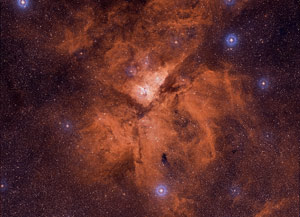The Carina nebula is a sprawling, monstrous complex of gas located a mere 7500 light years from Earth. Hundreds of light years across, it’s massive enough to create thousands of stars like the Sun. Tens of thousands.
And churn out stars it does. Embedded in the nebula are several clusters of newborn stars, and many of these stars are so massive they’re nearly at the limit of how big a star can be without tearing itself apart. Stars that big explode as supernovae, and a new mosaic by the orbiting Chandra X-ray Observatory indicate they’ve been popping off in the nebula for quite some time:
[Click to enchandrasekharlimitenate.]
This image is pretty amazing: it’s a mosaic of 22 separate images by Chandra, covering 1.4 square degrees (seven times the area of the full Moon on the sky), and represents an exposure time of 1.2 million seconds! Since it shows X-rays coming from astronomical objects, it’s false color: red is from lower energy X-rays, green is medium energy, and blue from the highest energy photons.
The diffuse glow is from two sources: the stellar winds from those massive stars slamming into surrounding ambient gas at high speed, and from the shock waves generated when supernovae explode. Both are extremely high-energy events, and produce copious amounts of X-rays. That long, horizontal arc is probably the edge of a bubble, a shell of gas piled up from the winds of stars and supernovae like snow piled up in front of a snowplow.
That’s evidence right there that Carina has been cranking out supernovae over the past few million years. Interestingly, it’s what’s missing that provides more proof. Look near the top of the image; see that loose cluster of stars right near the top edge? That’s Trumpler 15, a collection of thousands of stars packed into a volume of space only a few light years across (compare that to the Sun’s neighborhood, where the nearest star is over 4 light years away).
About 900 of the stars in Trumpler 15 are massive enough to produce X-rays and be seen by Chandra, and the highest mass of these stars should be cranking out lots of the highest-energy X-rays. However, this high-energy emission isn’t seen. Those stars should be there, but aren’t. The conclusion is clear: those stars are gone. The most massive stars only live a few million years before going boom, and the cluster is roughly 8 million years old – plenty of time for those stars to have gone supernova. In other words, Trumpler 15 is has been seeing some action lately.
 There are other clusters in the nebula as well, and you can see them in the picture (an annotated version is available as well); Trumpler 14 is below and to the right of Trumpler 15; Trumpler 16 is below 15 and just above the curving arc of shocked gas (Eta Carinae, a supermassive star just waiting to explode, can be seen just above that). All told, there are over 14,000 stars detected in this image, and that just includes the ones putting out X-rays. Many, many more can be seen in visible light pictures such as the one inset here (and yes, you very much want to click to embiggen it).
There are other clusters in the nebula as well, and you can see them in the picture (an annotated version is available as well); Trumpler 14 is below and to the right of Trumpler 15; Trumpler 16 is below 15 and just above the curving arc of shocked gas (Eta Carinae, a supermassive star just waiting to explode, can be seen just above that). All told, there are over 14,000 stars detected in this image, and that just includes the ones putting out X-rays. Many, many more can be seen in visible light pictures such as the one inset here (and yes, you very much want to click to embiggen it).
Not only that, but this Chandra survey has shown that the number of massive stars in the nebula is probably twice what we previously thought, and has also revealed six new possible neutron stars – the leftover cores of exploded massive stars. So the big conclusion to draw is that Carina has been churning out massive stars for quite some time, and for the past few million years the most massive of these have been exploding one after the other.
That may sound dangerous – stars exploding like flash bulbs in a nearby gas complex, aiiiee!! – but remember, the nebula is actually pretty far away. A supernova has to be less than 100 light years away to hurt us, and more like 25 light years away to really hurt us, so the nebula’s distance of 7500 light years means we’re safe from death by supernova.
But it does mean we get an excellent view of this star-explodey factory. There’s still much to learn about how stars are born, how they live out their lives, and how they die. Chandra’s X-ray vision is providing us with a big piece of that knowledge.
Image credits: NASA/CXC; Digitized Sky Survey/CXC
Related posts:
- Hubble’s 17th: chaos, birth, and near-death
- Hubble celebrates 20 years in space with a jaw-dropper
- ESO unlocks the Keyhole
- Hubble Heritage diamond gift